The Vivo V25 is a solid mid-range Android phone with a textured glass back, bringing a kind of class you don’t often see at the price. However, it’s a little hard to get hold of in some western markets and is not as hot for entertainment as some rivals.
Pros
- Textured glass rear panel
- Vibrant screen
- Solid primary camera
- Surprisingly long battery life
Cons
- Mono speaker
- Lacks some of the gaming power and low-light photo ability of the V25 Pro
- Severe straight-sided design
- Aggressive power management software may annoy
Availability
- UKTBC
- USAunavailable
- Europeunavailable
- Canadaunavailable
- Australiaunavailable
-
MediaTek Dimensity 900 processorA capable mid-range SoC that performs well for most tasks -
Multiple camerasThree rear cameras, a 64MP wide, an 8MP ultra-wide and a 2MP macro.
Introduction
The Vivo V25 is a mid-range Android phone, a lower-end alternative to the Vivo V25 Pro I reviewed recently. These two mobiles share no more than a name and some Vivo software traits, though.
Where that step-up model has a good gaming GPU, remarkably decent camera and unusual curved glass design, the Vivo V25 only stands out in one key way.
The Vivo V25 has a frosted glass back, one far harder and smoother than the plastic most phones at the price use. However, the design is also rather hard-edged, which won’t appeal to everyone.
Outside of the glass, the Vivo V25 doesn’t manage to stand out much, although its real-world battery life is very good considering it has a battery capacity of a so-so 4500mAh. That weak endorsement is more a reflection on the competition at this price range, though, as the camera is decent, the screen very good and the performance solid.
Availability is the biggest hurdle here. The Vivo V25 starts at ₹27999 in India, but is not widely available in the UK. That Indian price means it sits just above the OnePlus Nord 2T, which may be a more sensible buy unless you are really into the V25’s design.
Design and Screen
- Hard but smooth textured glass back
- Relatively sharp-sided design
- Mono speaker
The Vivo V25 is a severe phone. Its ultra-straight sides would feel outright sharp were it not for the bevelling at the corners. And the brick-like shape makes you feel every millimetre of its thickness.
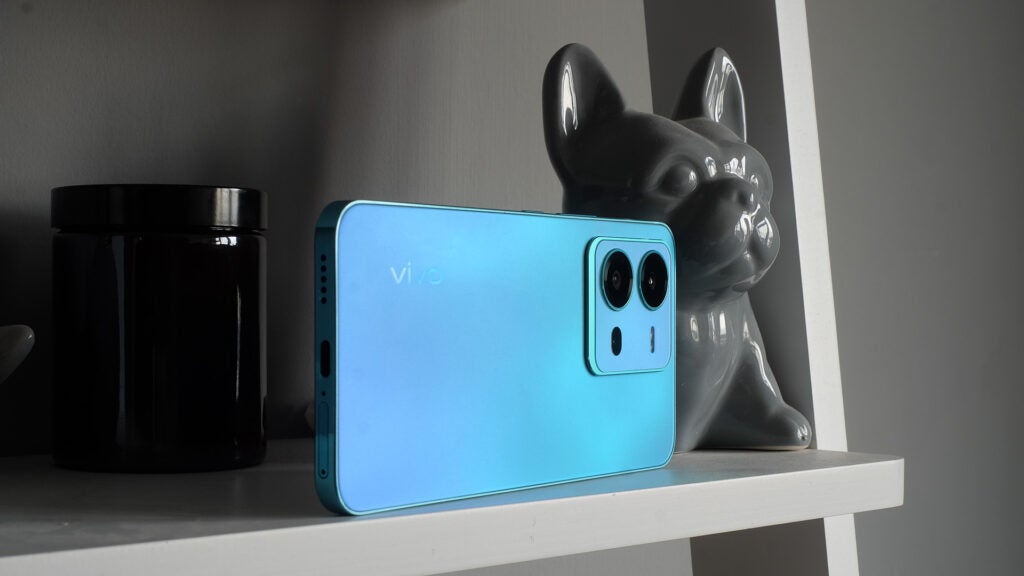
This phone is not thick or wide, but it feels chunkier than the V25 Pro I just switched from — and that’s a thicker phone. It seems inspired by recent iPhone designs.
That said, the specifics of construction are one of the Vivo V25’s standout parts. Its back is lightly frosted glass, with a green to turquoise finish running across its back. This feels dramatically better than the plastic seen in most phones at this level, at least to my fingers, and will be less susceptible to scratches and scuffs from everyday scrapes.
Vivo does not detail the sort of glass it uses on its website. But other sources suggest it is Schott Xensation Up, not the much better-known Gorilla Glass. I don’t perform torture testing as part of my review process, but it has not picked up any visible marks after a few weeks of fairly careless use. No case. Occasional pocket cohabitation with loose change and keys. And so on.
The Vivo V25 has no water resistance rating either, Vivo only claims it is “drop, scratch and sweat” resistant. This suggests there is at least minimal rubberised sealing of the points where water ingress is most likely to cause a problem.
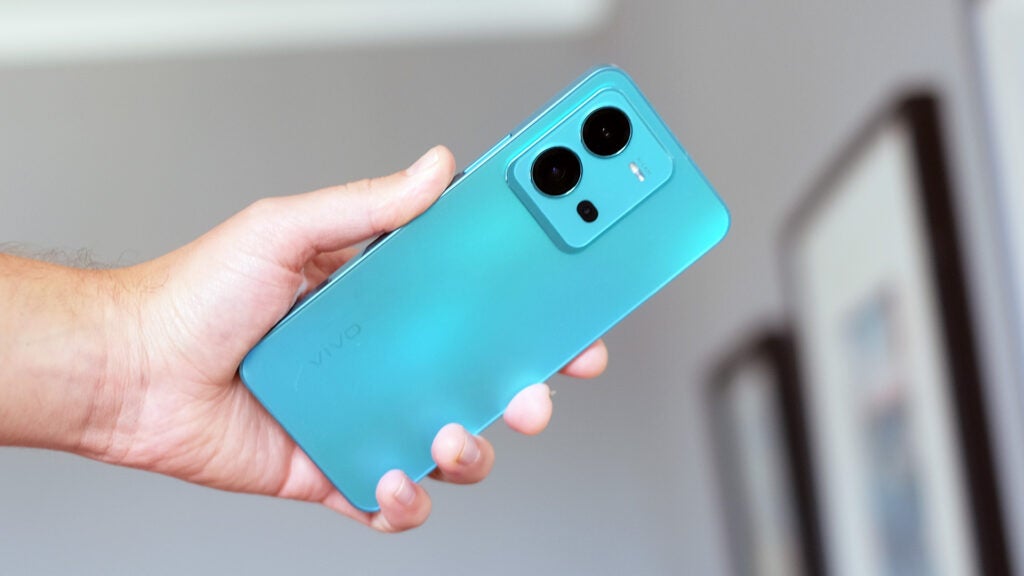
I don’t personally consider this a big issue, as anything below IP67 should probably not be trusted that much anyway.
As in the Vivo V25 Pro, the Vivo V25 has perhaps one too many high-end design traits for its own good. There’s no headphone jack, and the flat sides let you see the wide expanse where one could easily fit. You can’t add a microSD card either. Both of these are moves that are likely to put off some buyers who might otherwise be attracted to the phone.
It does have an in-screen fingerprint scanner, which works well. This style still feels more high-end than the side-loaded kind, but I’m way beyond the point of thinking there’s any real benefit to this type over the classic side style. This one works well, though.
Vivo made the V25 to appeal to those who care a lot about outer look and feel. Nothing wrong with that, but I don’t think it is as successful as the V25 Pro, which hides some of the phone thickness with dual curved panels.
The Vivo V25 has a 6.44-inch OLED panel with a 90Hz refresh rate. You can find 120Hz displays for around this price, but unless you are upgrading from such a phone I don’t think 90Hz is a huge downgrade. And it is likely crucial to delivering the phone’s pretty solid battery life. More on that later.
As is almost guaranteed with an OLED panel, contrast is superb and colour is punchy. There are three colour modes: standard, professional, bright. The first two are solid, and I recommend “professional”. It looks great – seeming more saturated than the sRGB to my eyes, but that standard looks very reserved on a phone these days.
Resolution is an unusual-sounding but ultimately ordinary 2404 x 1080 pixels and there’s a teardrop notch up top.
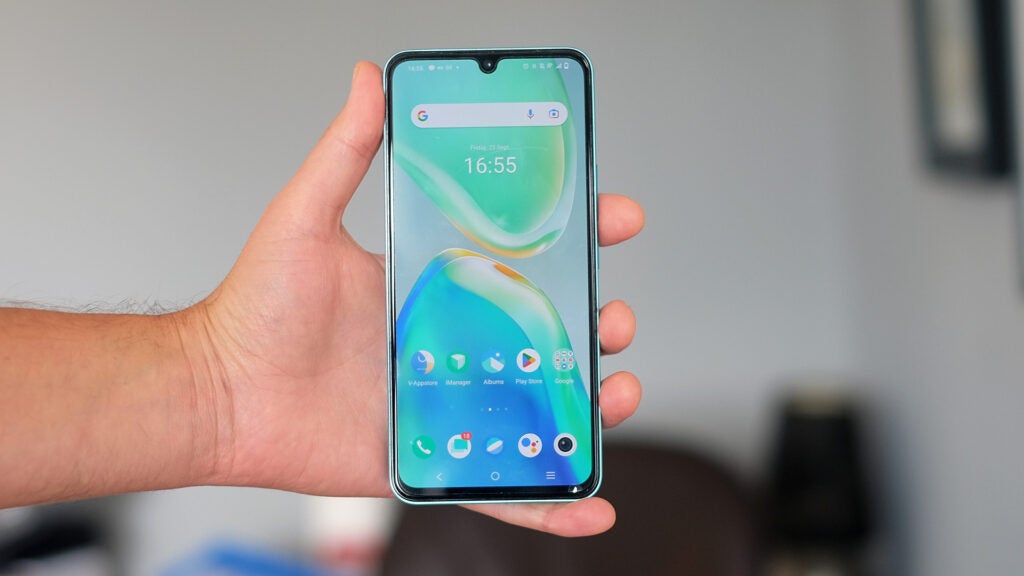
Vivo says the display can reach up to 1300 nits, but you won’t see this play out in reality. Doing my best to get the Vivo V25 to kick into its high brightness mode, which switches on when you’re outdoors in bright sunlight, it reached 780 nits. This is enough to make the screen bright enough for comfortable outdoor use, and is among the highest I’ve seen in an affordable phone.
On playing HDR video the maximum brightness I could register was a similar 782 nits, still well below the stated 1300 nit figure. But it’s bright enough when it counts.
Performance
- Interface has questionable extras, but they don’t get in the way
- Solid general performance
- Not the best buy for gaming
The Vivo V25 runs Android 12 and has the Funtouch 12 interface. This is a fairly clean interface, with no nasty surprises in its layout. However, it is thick enough to overwrite most of the stylistic changes Google made with this version of the software. Still, it looks decent.
Widgets are FunTouch’s current obsession. The app drawer has a whole section dedicated to them. And there’s a bonus feature called Jovi Home which is a panel full of the things.
Both of these extras are not particularly useful. But they are out of the way enough to avoid becoming outright clutter. Jovi Home is an additional homescreen many may not even stumble upon.
I’ve found the Vivo V25’s performance completely solid. No obvious lag, no major bugs, no big irritations.
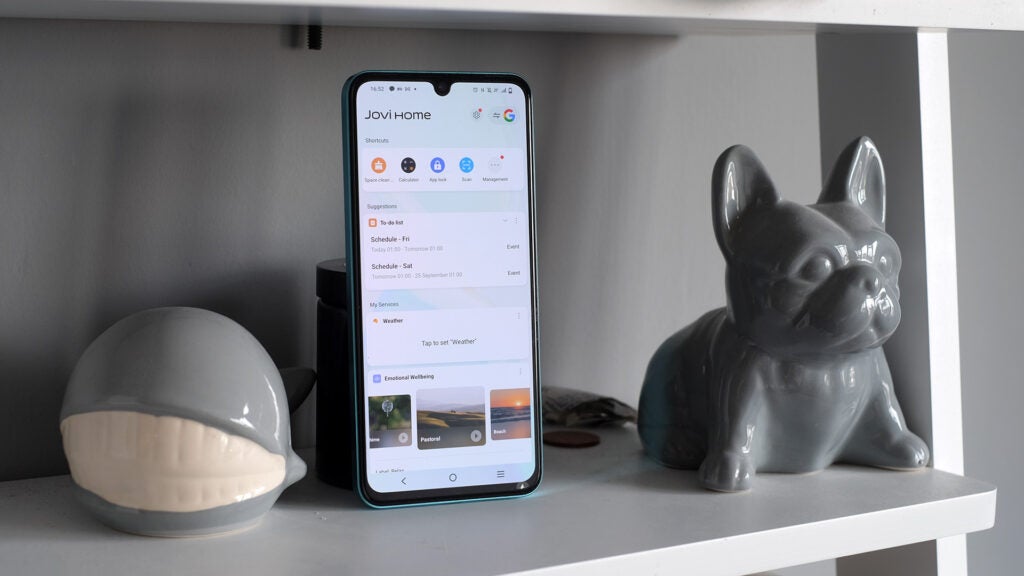
It has the MediaTek Dimensity 900 processor, a capable SoC with 5G and decent CPU performance, However, this is level just before MediaTek processors get really interesting, with the Dimensity 1200/1300. Vivo uses one of these in the Vivo V25 Pro.
Top-tier graphical performance is what the Dimensity 900 lacks. You can play most games just fine, but you can get much better gaming power for the same money (or less) with phones like the Xiaomi X4 GT.
It scores 2186 in 3DMark’s Wild Life test, compared to around 5800 in the X4 GT and 4600 in the Vivo V25 Pro.
It’s not a poor score, but it’s clear this is not a phone made for gaming. The mono speaker has just as much of an impact on this front. You want a stereo array for any games played in landscape, assuming you are not using headphones. This phone just has a single bottom speaker, with decent max volume but slightly harder tonality than the best in this class.
In better news, the Vivo V25 does not throttle significantly after an extended period of strain, and doesn’t get all that warm during play either.
Camera
- Decent results at night, but not as good as the V25 Pro
- Oversaturated colour
- A decent camera array for a budget phone
The Vivo V25 has three rear cameras, a 64MP wide, an 8MP ultra-wide and a 2MP macro. You see a similar arrangement in a great many affordable mid-range phones like this.
It shares several core strengths with the step-up Vivo V25 Pro. Auto HDR is super-effective, dramatically lowering how many duds you’ll take with this phone.
2x zoom images look solid enough until you enlarge them significantly too — a result considering the Vivo V25 doesn’t have a zoom lens. Zooming in the app relies on purely digital techniques.
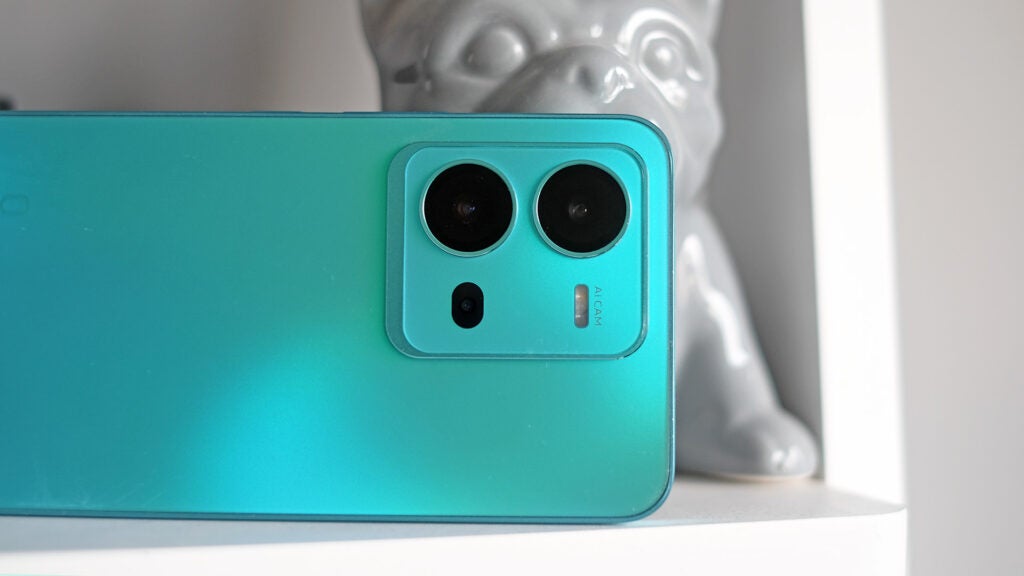
The Vivo V25 camera didn’t win me over to the same extent as the V25 Pro, though, because the low-light images just aren’t quite as good. This phone has a real tendency not to focus properly at night unless you specifically choose a focus point with your finger.
Night image quality is noticeably poorer too. This is because while the V25 and V25 Pro cameras look similar from a cursory glance at their specs, they are actually different. The V25 has a slightly smaller, lower-end 64MP sensor.
Low-light photos are typically better than those of some of the more gaming-focused budget Androids I mentioned earlier, in part because the optional Night mode is pretty effective at bringing out shadow detail, likely helped by OIS stabilisation. And with just a little, for example, street light, night shots can still look quite sharp. But it just does not quite hit the level of its Pro sibling.
I also find the Vivo V25 routinely amps up colour a little too much. Grass ends up too green, blue skies appear punchier than they actually were and some random bystander’s red t-shirt will look as if it has just been dye-dipped. The extent of this effect varies from scene to scene, but is a recurring trait of the Vivo V25.





The 8MP camera performs at the usual level for a phone of this class. Vivo’s good HDR optimisation can result in some immediately striking images, particularly during the day. However, the 8MP resolution means those pictures don’t hold up too well to close scrutiny, and it tends to fumble over more complicated natural textures.

The 2MP macro is quite poor, an unavoidable result of the very low sensor resolution. Here’s the best shot I got out of it:



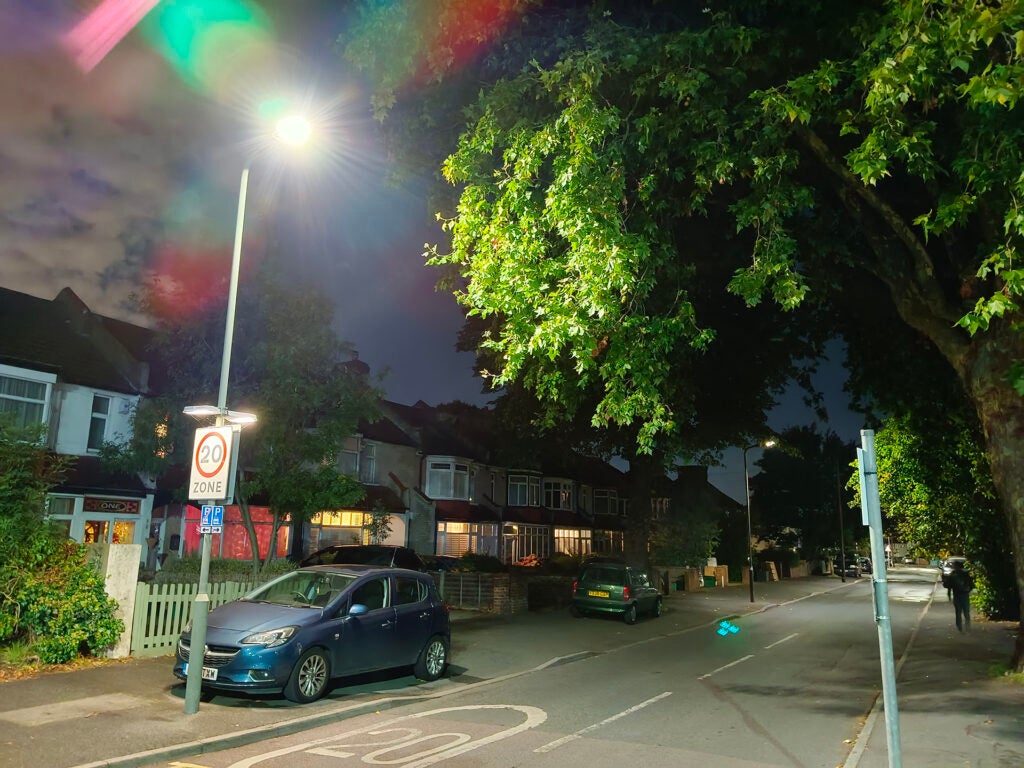
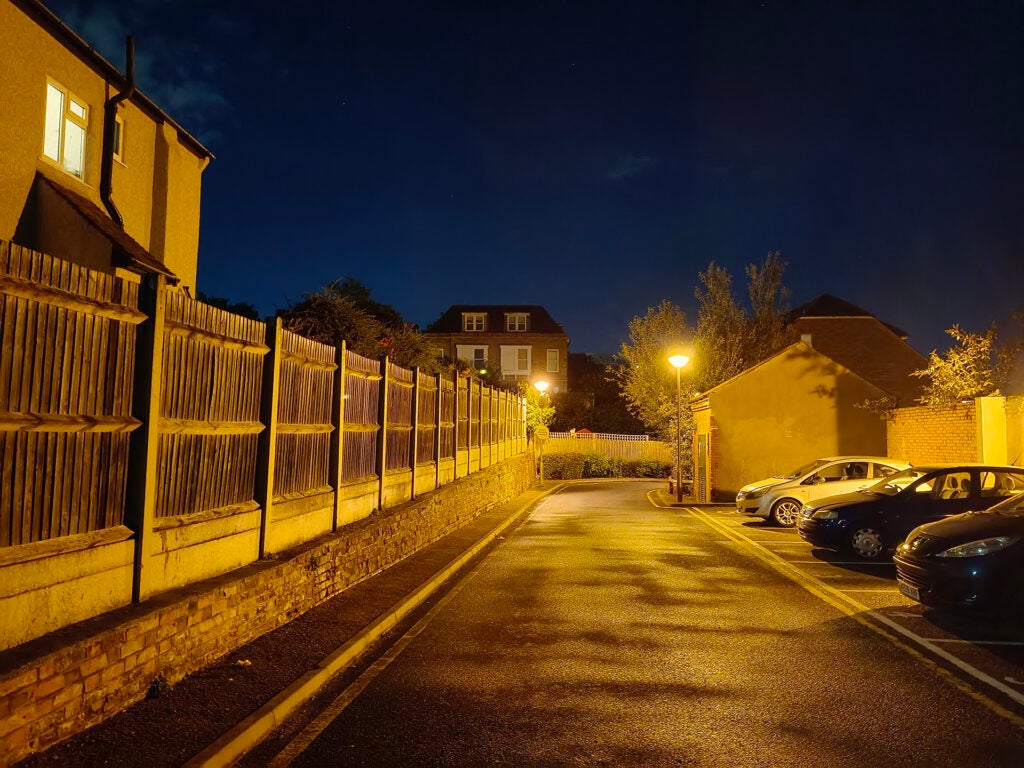

There are no deal-breaking hits to video features, compared to the pricier V25 Pro. You can still shoot 4K video at up 30 frames per second, with reasonably effective software stabilisation. Drop to 1080p capture and the Ultra stabilised mode is unlocked. This uses a much more dramatically cropped view to fuel the software stabilisation process.
The Vivo V25 Pro even has an HDR video mode. It’s limited to 1080p/30 capture, but is, again, stabilised. Decent 4K video that is usable in casual shooting scenarios is all I look for in a phone this like, so Vivo earns a solid pass.
An unusually high-res 50MP selfie camera sits around the other side of the phone, and it does a good job in almost all environments. Pics look sharp in good lighting, clean if not super-detailed in bad lighting, and the V25’s HDR once again lets it handle backlit scenes just fine.
Battery life
- Surprisingly good battery life, better than most 4500mAh phones
- Reasonably good fast charging
- No wireless charging
The Vivo V25 has a 4500mAh battery, 500mAh below what some competitors offer. Phones with this capacity often struggle to last a full day of my testing with much, if any, charge to spare. However, this one is a little different.
Stamina is unusually good here, almost bizarrely good. It has outlasted plenty of phone I’ve tested this year with higher capacity, and often ended up with around 40% charge left by the end of lighter days.
This appears to be down to rather aggressive back-end power management software that is quite strict about the processes allowed to run in the background. At times it is too proactive. For example, I had to exempt one of the radio streaming apps I used from any power use optimisation, otherwise the Vivo V25 would keep closing it down mid-stream.
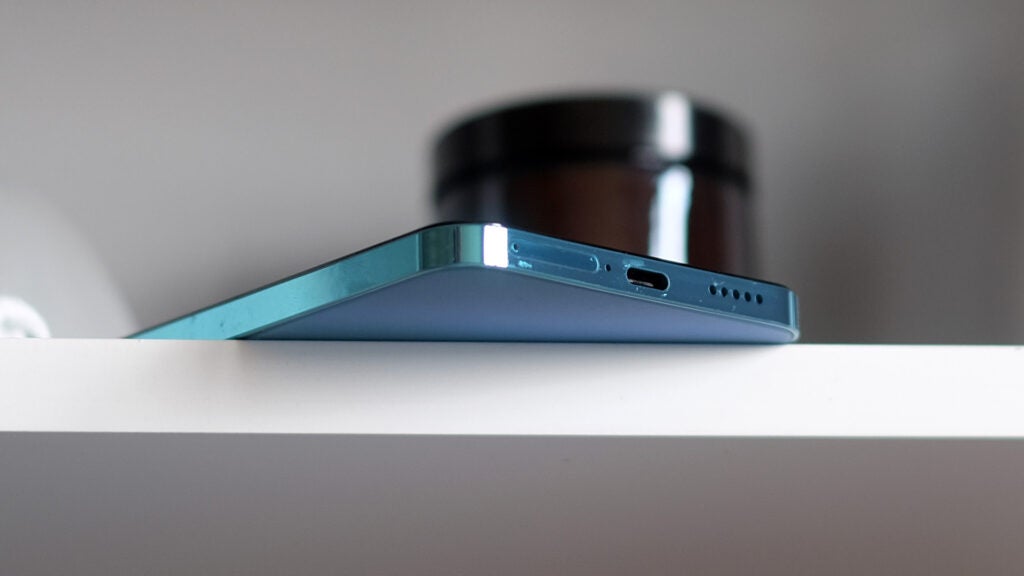
It’s no deal-breaking issue if you are aware of these tools, that you can give certain apps free rein. But some Vivo V25 buyers won’t realise this is an option.
The Vivo V25 has mid-tier 45W charging, but I find it almost a match for the 66W charging of the Vivo V25 Pro. It reaches 50% charge at the 12 minute mark, 100% at 55 minutes. This is because fast-charging phones have differing power curves, and often only hit their stated maximum charge speed for a couple of minutes. If that.
There’s no support for wireless charging here, the norm for this grade of Android.
Should you buy it?
At a reasonable price the Vivo V25 nets you a real glass back, a bright OLED screen and a few other high-end touches like an in-screen fingerprint scanner.
The Vivo V25 is not that easy to get hold of in some western countries, and is not the best buy around if you value gaming performance highly. It does the job fine, but others offer much better graphical power for similar money.
Final Thoughts
The Vivo V25 is a decent affordable mid-range Android phone well suited to those who want a glass-backed phone without spending a fortune.
It doesn’t have as many notable high points as the Vivo V25 Pro, though, as its gaming power is significantly worse and the camera does not perform quite as well at night.
The design, while still a stand out feature, won’t please everyone either. Its straight iPhone-like sides may seem too severe for some, and do not mask the phone’s (entirely fine) thickness like the V25 Pro’s curved glass style. Still, the rear textured glass does look and feel great compared to the plastic used in other models. From a UK perspective availability is perhaps the biggest issue. The Vivo V25 isn’t sold widely, and while good the phone isn’t worth paying additional customs charges for.
How we test
We test every mobile phone we review thoroughly. We use industry standard tests to compare features properly and we use the phone as our main device over the review period. We’ll always tell you what we find and we never, ever, accept money to review a product.
Used as our main handset during test period
Camera tested in variety of situations with all modes
Tested with synthetic benchmarks and real world use
FAQs
The phone has no official water resistance so should be used carefully around liquids.
There’s no wireless charging here, only cabled charging.
Vivo does not specify the glass used, but we believe it is not Gorilla Glass.
Trusted Reviews test data
Sustainability
Trusted Reviews holds the fact that global warming is not a myth as a core value and will continuously endeavor to help protect our planet from harm in its business practices.
As part of this mission, whenever we review a product we send the company a series of questions to help us gauge and make transparent the impact the device has on the environment.
You can see a detailed breakdown of the questions we ask and why in our sustainability info page. In lieu of answering each of these questions, Vivo has provided us with its company Sustainability Report.
The Vivo V25 is a solid mid-range Android phone with a textured glass back, bringing a kind of class you don’t often see at the price. However, it’s a little hard to get hold of in some western markets and is not as hot for entertainment as some rivals.
Pros
- Textured glass rear panel
- Vibrant screen
- Solid primary camera
- Surprisingly long battery life
Cons
- Mono speaker
- Lacks some of the gaming power and low-light photo ability of the V25 Pro
- Severe straight-sided design
- Aggressive power management software may annoy
Availability
- UKTBC
- USAunavailable
- Europeunavailable
- Canadaunavailable
- Australiaunavailable
-
MediaTek Dimensity 900 processorA capable mid-range SoC that performs well for most tasks -
Multiple camerasThree rear cameras, a 64MP wide, an 8MP ultra-wide and a 2MP macro.
Introduction
The Vivo V25 is a mid-range Android phone, a lower-end alternative to the Vivo V25 Pro I reviewed recently. These two mobiles share no more than a name and some Vivo software traits, though.
Where that step-up model has a good gaming GPU, remarkably decent camera and unusual curved glass design, the Vivo V25 only stands out in one key way.
The Vivo V25 has a frosted glass back, one far harder and smoother than the plastic most phones at the price use. However, the design is also rather hard-edged, which won’t appeal to everyone.
Outside of the glass, the Vivo V25 doesn’t manage to stand out much, although its real-world battery life is very good considering it has a battery capacity of a so-so 4500mAh. That weak endorsement is more a reflection on the competition at this price range, though, as the camera is decent, the screen very good and the performance solid.
Availability is the biggest hurdle here. The Vivo V25 starts at ₹27999 in India, but is not widely available in the UK. That Indian price means it sits just above the OnePlus Nord 2T, which may be a more sensible buy unless you are really into the V25’s design.
Design and Screen
- Hard but smooth textured glass back
- Relatively sharp-sided design
- Mono speaker
The Vivo V25 is a severe phone. Its ultra-straight sides would feel outright sharp were it not for the bevelling at the corners. And the brick-like shape makes you feel every millimetre of its thickness.

This phone is not thick or wide, but it feels chunkier than the V25 Pro I just switched from — and that’s a thicker phone. It seems inspired by recent iPhone designs.
That said, the specifics of construction are one of the Vivo V25’s standout parts. Its back is lightly frosted glass, with a green to turquoise finish running across its back. This feels dramatically better than the plastic seen in most phones at this level, at least to my fingers, and will be less susceptible to scratches and scuffs from everyday scrapes.
Vivo does not detail the sort of glass it uses on its website. But other sources suggest it is Schott Xensation Up, not the much better-known Gorilla Glass. I don’t perform torture testing as part of my review process, but it has not picked up any visible marks after a few weeks of fairly careless use. No case. Occasional pocket cohabitation with loose change and keys. And so on.
The Vivo V25 has no water resistance rating either, Vivo only claims it is “drop, scratch and sweat” resistant. This suggests there is at least minimal rubberised sealing of the points where water ingress is most likely to cause a problem.

I don’t personally consider this a big issue, as anything below IP67 should probably not be trusted that much anyway.
As in the Vivo V25 Pro, the Vivo V25 has perhaps one too many high-end design traits for its own good. There’s no headphone jack, and the flat sides let you see the wide expanse where one could easily fit. You can’t add a microSD card either. Both of these are moves that are likely to put off some buyers who might otherwise be attracted to the phone.
It does have an in-screen fingerprint scanner, which works well. This style still feels more high-end than the side-loaded kind, but I’m way beyond the point of thinking there’s any real benefit to this type over the classic side style. This one works well, though.
Vivo made the V25 to appeal to those who care a lot about outer look and feel. Nothing wrong with that, but I don’t think it is as successful as the V25 Pro, which hides some of the phone thickness with dual curved panels.
The Vivo V25 has a 6.44-inch OLED panel with a 90Hz refresh rate. You can find 120Hz displays for around this price, but unless you are upgrading from such a phone I don’t think 90Hz is a huge downgrade. And it is likely crucial to delivering the phone’s pretty solid battery life. More on that later.
As is almost guaranteed with an OLED panel, contrast is superb and colour is punchy. There are three colour modes: standard, professional, bright. The first two are solid, and I recommend “professional”. It looks great – seeming more saturated than the sRGB to my eyes, but that standard looks very reserved on a phone these days.
Resolution is an unusual-sounding but ultimately ordinary 2404 x 1080 pixels and there’s a teardrop notch up top.

Vivo says the display can reach up to 1300 nits, but you won’t see this play out in reality. Doing my best to get the Vivo V25 to kick into its high brightness mode, which switches on when you’re outdoors in bright sunlight, it reached 780 nits. This is enough to make the screen bright enough for comfortable outdoor use, and is among the highest I’ve seen in an affordable phone.
On playing HDR video the maximum brightness I could register was a similar 782 nits, still well below the stated 1300 nit figure. But it’s bright enough when it counts.
Performance
- Interface has questionable extras, but they don’t get in the way
- Solid general performance
- Not the best buy for gaming
The Vivo V25 runs Android 12 and has the Funtouch 12 interface. This is a fairly clean interface, with no nasty surprises in its layout. However, it is thick enough to overwrite most of the stylistic changes Google made with this version of the software. Still, it looks decent.
Widgets are FunTouch’s current obsession. The app drawer has a whole section dedicated to them. And there’s a bonus feature called Jovi Home which is a panel full of the things.
Both of these extras are not particularly useful. But they are out of the way enough to avoid becoming outright clutter. Jovi Home is an additional homescreen many may not even stumble upon.
I’ve found the Vivo V25’s performance completely solid. No obvious lag, no major bugs, no big irritations.

It has the MediaTek Dimensity 900 processor, a capable SoC with 5G and decent CPU performance, However, this is level just before MediaTek processors get really interesting, with the Dimensity 1200/1300. Vivo uses one of these in the Vivo V25 Pro.
Top-tier graphical performance is what the Dimensity 900 lacks. You can play most games just fine, but you can get much better gaming power for the same money (or less) with phones like the Xiaomi X4 GT.
It scores 2186 in 3DMark’s Wild Life test, compared to around 5800 in the X4 GT and 4600 in the Vivo V25 Pro.
It’s not a poor score, but it’s clear this is not a phone made for gaming. The mono speaker has just as much of an impact on this front. You want a stereo array for any games played in landscape, assuming you are not using headphones. This phone just has a single bottom speaker, with decent max volume but slightly harder tonality than the best in this class.
In better news, the Vivo V25 does not throttle significantly after an extended period of strain, and doesn’t get all that warm during play either.
Camera
- Decent results at night, but not as good as the V25 Pro
- Oversaturated colour
- A decent camera array for a budget phone
The Vivo V25 has three rear cameras, a 64MP wide, an 8MP ultra-wide and a 2MP macro. You see a similar arrangement in a great many affordable mid-range phones like this.
It shares several core strengths with the step-up Vivo V25 Pro. Auto HDR is super-effective, dramatically lowering how many duds you’ll take with this phone.
2x zoom images look solid enough until you enlarge them significantly too — a result considering the Vivo V25 doesn’t have a zoom lens. Zooming in the app relies on purely digital techniques.

The Vivo V25 camera didn’t win me over to the same extent as the V25 Pro, though, because the low-light images just aren’t quite as good. This phone has a real tendency not to focus properly at night unless you specifically choose a focus point with your finger.
Night image quality is noticeably poorer too. This is because while the V25 and V25 Pro cameras look similar from a cursory glance at their specs, they are actually different. The V25 has a slightly smaller, lower-end 64MP sensor.
Low-light photos are typically better than those of some of the more gaming-focused budget Androids I mentioned earlier, in part because the optional Night mode is pretty effective at bringing out shadow detail, likely helped by OIS stabilisation. And with just a little, for example, street light, night shots can still look quite sharp. But it just does not quite hit the level of its Pro sibling.
I also find the Vivo V25 routinely amps up colour a little too much. Grass ends up too green, blue skies appear punchier than they actually were and some random bystander’s red t-shirt will look as if it has just been dye-dipped. The extent of this effect varies from scene to scene, but is a recurring trait of the Vivo V25.





The 8MP camera performs at the usual level for a phone of this class. Vivo’s good HDR optimisation can result in some immediately striking images, particularly during the day. However, the 8MP resolution means those pictures don’t hold up too well to close scrutiny, and it tends to fumble over more complicated natural textures.

The 2MP macro is quite poor, an unavoidable result of the very low sensor resolution. Here’s the best shot I got out of it:






There are no deal-breaking hits to video features, compared to the pricier V25 Pro. You can still shoot 4K video at up 30 frames per second, with reasonably effective software stabilisation. Drop to 1080p capture and the Ultra stabilised mode is unlocked. This uses a much more dramatically cropped view to fuel the software stabilisation process.
The Vivo V25 Pro even has an HDR video mode. It’s limited to 1080p/30 capture, but is, again, stabilised. Decent 4K video that is usable in casual shooting scenarios is all I look for in a phone this like, so Vivo earns a solid pass.
An unusually high-res 50MP selfie camera sits around the other side of the phone, and it does a good job in almost all environments. Pics look sharp in good lighting, clean if not super-detailed in bad lighting, and the V25’s HDR once again lets it handle backlit scenes just fine.
Battery life
- Surprisingly good battery life, better than most 4500mAh phones
- Reasonably good fast charging
- No wireless charging
The Vivo V25 has a 4500mAh battery, 500mAh below what some competitors offer. Phones with this capacity often struggle to last a full day of my testing with much, if any, charge to spare. However, this one is a little different.
Stamina is unusually good here, almost bizarrely good. It has outlasted plenty of phone I’ve tested this year with higher capacity, and often ended up with around 40% charge left by the end of lighter days.
This appears to be down to rather aggressive back-end power management software that is quite strict about the processes allowed to run in the background. At times it is too proactive. For example, I had to exempt one of the radio streaming apps I used from any power use optimisation, otherwise the Vivo V25 would keep closing it down mid-stream.

It’s no deal-breaking issue if you are aware of these tools, that you can give certain apps free rein. But some Vivo V25 buyers won’t realise this is an option.
The Vivo V25 has mid-tier 45W charging, but I find it almost a match for the 66W charging of the Vivo V25 Pro. It reaches 50% charge at the 12 minute mark, 100% at 55 minutes. This is because fast-charging phones have differing power curves, and often only hit their stated maximum charge speed for a couple of minutes. If that.
There’s no support for wireless charging here, the norm for this grade of Android.
Should you buy it?
At a reasonable price the Vivo V25 nets you a real glass back, a bright OLED screen and a few other high-end touches like an in-screen fingerprint scanner.
The Vivo V25 is not that easy to get hold of in some western countries, and is not the best buy around if you value gaming performance highly. It does the job fine, but others offer much better graphical power for similar money.
Final Thoughts
The Vivo V25 is a decent affordable mid-range Android phone well suited to those who want a glass-backed phone without spending a fortune.
It doesn’t have as many notable high points as the Vivo V25 Pro, though, as its gaming power is significantly worse and the camera does not perform quite as well at night.
The design, while still a stand out feature, won’t please everyone either. Its straight iPhone-like sides may seem too severe for some, and do not mask the phone’s (entirely fine) thickness like the V25 Pro’s curved glass style. Still, the rear textured glass does look and feel great compared to the plastic used in other models. From a UK perspective availability is perhaps the biggest issue. The Vivo V25 isn’t sold widely, and while good the phone isn’t worth paying additional customs charges for.
How we test
We test every mobile phone we review thoroughly. We use industry standard tests to compare features properly and we use the phone as our main device over the review period. We’ll always tell you what we find and we never, ever, accept money to review a product.
Used as our main handset during test period
Camera tested in variety of situations with all modes
Tested with synthetic benchmarks and real world use
FAQs
The phone has no official water resistance so should be used carefully around liquids.
There’s no wireless charging here, only cabled charging.
Vivo does not specify the glass used, but we believe it is not Gorilla Glass.
Trusted Reviews test data
Sustainability
Trusted Reviews holds the fact that global warming is not a myth as a core value and will continuously endeavor to help protect our planet from harm in its business practices.
As part of this mission, whenever we review a product we send the company a series of questions to help us gauge and make transparent the impact the device has on the environment.
You can see a detailed breakdown of the questions we ask and why in our sustainability info page. In lieu of answering each of these questions, Vivo has provided us with its company Sustainability Report.

























